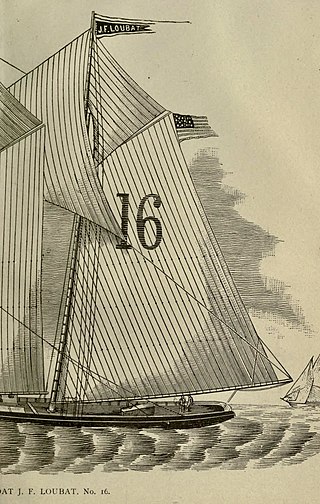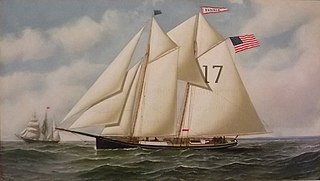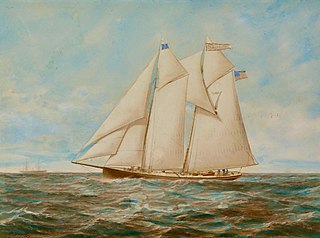
USS Hope was a 19th-century wooden yacht schooner, designed and built in 1861 by Henry Steers for Captain Thomas B. Ives of Providence, Rhode Island. She was acquired by the Union Navy during the American Civil War. She was placed into service as a gunboat assigned to support the fleet blockading the ports of the Confederate States of America. However, at times, Hope was assigned extra tasks, such as that of a dispatch boat, supply runner and salvage ship. She was a pilot boat from 1866 to 1891 and in 1891 she was replaced by the Herman Oelrichs, when the Hope was wrecked ashore the Sandy Hook Point.

Samuel Havre Pine, was a 19th-century American ship designer and builder located in Greenpoint, Brooklyn. He built the racing yacht Enchantress as well as many sailing schooners and yachts; steam yachts; and steamships.

The Joseph F. Loubat was a 19th-century Sandy Hook pilot boat built in 1880 at the Jacob S. Ellis shipyard in Tottenville, Staten Island. She was the largest of the pilot-boats in the Sandy Hook service. In 1896 she was one of the last pilot-boats that were sold in an age of steam and electricity.

The Isaac Webb was a 19th-century Sandy Hook pilot boat built in 1860 by Webb & Bell for the New York and Sandy Hook pilots. She received a reward by the Board of Pilot Commissioners of New York for saving three sailors from the wreck of the bark Sarah, that was caught up in a hurricane. The Webb was shipwrecked in a dense fog at Quonochontaug Beach, Long Island in 1879. She was replaced by pilot boat Columbia.

The Fannie was a 19th-century Sandy Hook pilot boat built in 1860 by Edward F. Williams at his shipyard in Greenpoint, Brooklyn for New York City pilots. She was in the pilot service during the American Civil War. In an age of steam, she was sold in 1896.

The Thomas S. Negus was a 19th-century two-masted Sandy Hook pilot boat, built by C. & R. Poillon shipyard in Brooklyn in 1873 for the New Jersey maritime pilots. She was built to replace the pilot boat Jane, No. 1, which sank in early 1873. She was the winner of a $1,000 prize at the Cape May Regatta in 1873. She was named for Thomas S. Negus, president of the N. J. Pilots' Commissioners. In 1897, she left the pilot service to prospect for gold during the Klondike Gold Rush.

The Edwin Forrest was a 19th-century pilot boat built in 1855 by Jacob A. Westervelt's Sons & Co., for a group of New York pilots. She was designed by Dennison J. Lawlor, for Pilot Captain John Low. The Edwin Forrest was named in honor of the American actor Edwin Forrest. A second Edwin Forrest was built for Boston pilots in 1865 to replace the New York Edwin Forrest, No. 14, that was lost in 1862. She attained celebrity for her speed and stability. The Edwin Forrest was sold to Pensacola, Florida parties in 1882 and replaced by the George H. Warren.

The Charles H. Marshall was a 19th-century Sandy Hook pilot boat built by Henry Steers in 1860 for a group of New York pilots. She was in the Great Blizzard of 1888, the same year the National Geographic came out with an article about the successful struggle made by the crew of the Marshall. The boat was named in honor of the American businessman Charles Henry Marshall. In the age of steam she was sold in 1896.

The Mary A. Williams was a 19th-century Sandy Hook pilot boat, built in 1861 by the shipbuilder Edward F. Williams in Greenpoint, Brooklyn, for a group of New York pilots. She was named Mary Ann Williams after the wife of the builder. The boat was considered one of the finest connected with the pilot service. She survived the Great Blizzard of 1888. In the age of steam, the Mary A. Williams was sold in 1896.

The Christian Bergh was a 19th-century Sandy Hook pilot boat built in 1851 at the Westervelt & Co. shipyard. She later became a Pennsylvania pilot boat until her service ended in 1886 when she became an oyster boat in the Delaware Bay. She was named after Christian Bergh a prominent shipbuilder in New York and a close friend of Jacob Westervelt.

Edmund Blunt was a 19th-century New York pilot boat built in 1858 by Edward F. Williams for the New York Pilots. She helped transport New York City maritime pilots between inbound or outbound ships coming into the New York Harbor. She survived the Great Blizzard of 1888. In the age of steam, the Blunt along with other pilot boats, were replaced with steamboats. She was built to replace the Jacob L. Westervelt, which sank in 1857.
Michael Murphy, was a 19th-century American New York Sandy Hook maritime pilot. He was best known for being in the Sandy Hook service for over 34 years. Murphy was captain and owner of the pilot boats, Washington,Abraham Leggett, and Alexander M. Lawrence. He piloted the Great Eastern from Southampton to New York in 1860.

The Mary E. Fish was a 19th-century Sandy Hook pilot boat, built at the Edward F. Williams shipyard of Greenpoint, Brooklyn in 1861 for Richard Brown and the New York Pilots. She was built to replace the Mary Taylor. The Fish was hit and sank by the schooner Frank Harrington in 1885 and replaced by the David Carll.
The James Gordon Bennett was a 19th-century two-masted pilot boat, built in 1870 at the Lawrence & Foulks shipyard. She was named in honor of James Gordon Bennett, Jr., publisher of the New York Herald. She went ashore in 1893 and was rebuilt at the C. & R. Poillon shipyard. In 1897, the James Gordon Bennett was bought by Miller J. Morse of the Atlantic Yacht Club and made into a yacht. He changed her name to Hermit. The New Jersey pilots purchased her in 1901, to replace the David T. Leahy, that was run down by the steamship Alene. The Hermit sank in 1906, when the steamship Monterey ran into her.

The Edmund Driggs was a 19th-century Sandy Hook pilot boat built in 1864 at the Edward F. Williams shipyard in Greenpoint, Brooklyn. She was built to replace the pilot boat Elwood Walter. The schooner was used to pilot vessels to and from the Port of New York. She survived the Great Blizzard of 1888. In the age of steam, she was sold in 1896.

The Enchantress was a 19th-century Sandy Hook pilot boat built in 1851 by John Maginn who named her after one of the cast in the opera The Enchantress. She was launched from the Westervelt & McKay shipyard. The Enchantress was one of the oldest pilot-boats in the service. She was Cornelius Vanderbilt's favorite pilot boat. The Enchantress went down with all hands in the Great Blizzard of 1888. The pilot boat James Stafford was built to replace her.

The James W. Elwell was a 19th-century two-masted Sandy Hook pilot boat, built in 1867 by John A. Forsyth at Mystic Bridge, New London, Connecticut for New Jersey and Sandy Hook maritime pilots. She raced for a $1,000 prize at the Cape May Regatta in 1873. She went ashore and was shipwrecked on North Beach Haven, New Jersey in 1875.

Jacob Samson Ellis, was a 19th-century prominent shipbuilder in Tottenville, Staten Island. He had a large successful shipyard business for over thirty years, with a reputation for his skill in designing vessels. Ellis died in Tottenville in 1902. His son, Hampton C. Ellis, continued with the shipyard constructing boats through the 1920s.
Walter Brewer was a 19th-century American harbor pilot who guided large vessels into and out of New York Harbor as a Sandy Hook pilot. He was part owner of the pilot boats Virginia, William H. Aspinwall and the America, of the New York fleet.
















